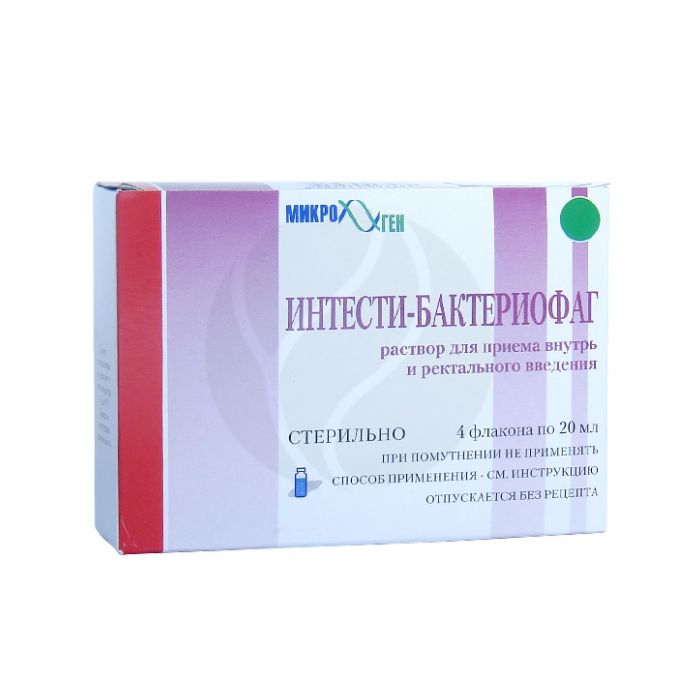Intesty-bacteriophage solution 20ml, No. 4
Expiration Date: 05/2027
Russian Pharmacy name:
Интести-бактериофаг раствор 20мл, №4
Treatment and prevention of gastrointestinal diseases caused by dysentery bacteria, Salmonella spp., Escherichia coli, Proteus spp., Enterococcus spp., Staphilococcus spp., Pseudomonas aeruginosa or a combination thereof:
bacterial dysentery;
salmonellosis; dyspepsia;
dysbiosis;
enterocolitis, colitis.
An important condition for effective phage therapy is a preliminary determination of the phage sensitivity of the pathogen.
The drug is intended for oral administration and rectal administration.
For treatment, the drug is taken orally 4 times a day 0.5-1 hours before meals from the first day of the disease for 7-10 days.
For children of the first months of life, in the first two days of taking the drug, the drug is diluted twice with boiled water, in the absence of adverse reactions (regurgitation, skin rashes), the bacteriophage can be used undiluted in the future. The drug is administered by mouth 3 times a day 30 minutes before feeding.
In cases of indomitable vomiting, the drug is used in the form of high enemas (through a gas tube or catheter) daily.
A combination of rectal (in the form of high enemas) and oral administration of the drug is possible. The course of treatment is 7-10 days.
In the absence of colitis, it is recommended to replace one oral administration with a single rectal administration of a single age-specific dose of the drug in the form of an enema after bowel movement.
For prophylactic purposes, the optimal scheme of use is a daily intake of a single age dose. The duration of taking the drug is determined by the conditions of the epidemiological situation.
Solution for oral administration or rectal administration
a mixture of sterile filtrates of phagolysates from Shigella flexneri 1, 2, 3, 4, 6 serovars, Shigella sonnei, Salmonella paratyphi A, Salmonella paratyphi B, Salmonella typhimurium, Salmonella infantis, Salmonella choleraesuis, Salmonella oranienburg, Salmonella enteropathogenic, various enteropathogenic significant in the etiology of enteric diseases, Proteus vulgaris, Proteus mirabilis, Enterococcus, Staphylococcus, Pseudomonas aeruginosa.
Excipients: quinosole 0.0001 g / ml
hypersensitivity to the components of the drug.
pharmachologic effect
The drug causes a specific lysis of bacteria Shigella flexneri 1, 2, 3, 4, 6 serovariants, Shigella sonnei, Salmonella paratyphi A, Salmonella paratyphi B, Salmonella typhymurium, Salmonella infantis, Salmonella choleraesuis, Salmonella oranichienburg, Salmonella enteritidis, Escherus vulherus Proteus mirabilis, Enterococcus, Staphylococcus, Pseudomonas aeruginosa.
Side effect
In children of the first months of life, in the first 2 days of taking the drug, regurgitation, rashes on the skin are possible.
special instructions
Do not use the drug in case of turbidity! Due to the content of the nutrient medium in the preparation, in which bacteria from the environment can develop, causing turbidity of the preparation, it is necessary to observe the following rules when opening the bottle: wash your hands thoroughly; treat the cap with an alcohol-containing solution; remove the cap without opening the plugs; do not put the cork with its inner surface on a table or other objects; do not leave the bottle open; store the opened bottle only in the refrigerator. When using small doses (2-8 drops), the drug must be taken with a sterile syringe in a volume of 0.5-1 ml. The drug from an opened bottle, subject to the storage conditions, the above rules and the absence of turbidity, can be used throughout the shelf life.
Information about the possible effect of the medicinal product on the ability to drive vehicles, mechanisms.
None.
Overdose
Overdose symptoms have not been established.
Drug interactions
The use of the drug is possible in combination with other drugs, including antibiotics.

